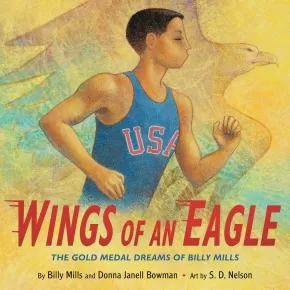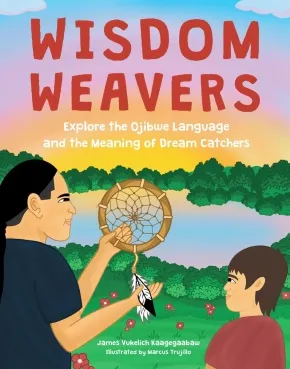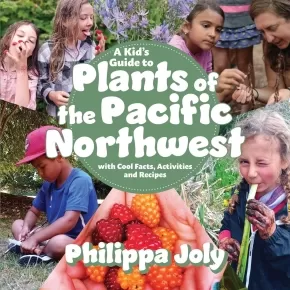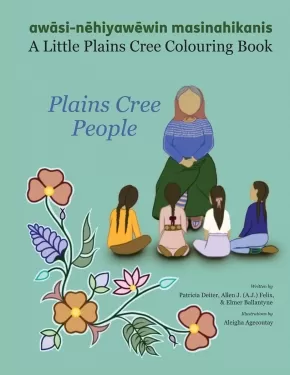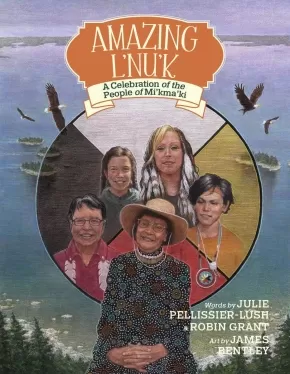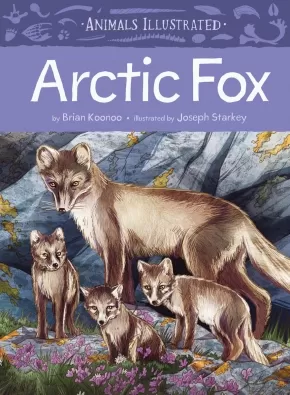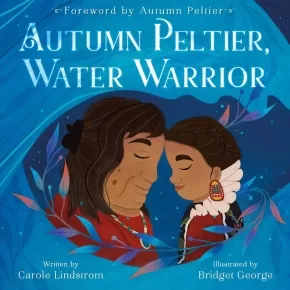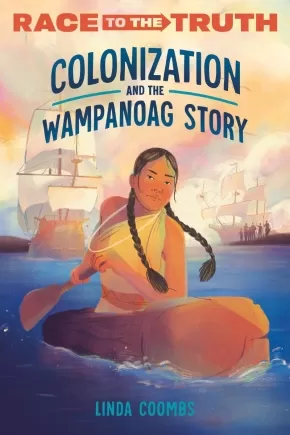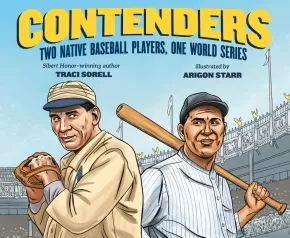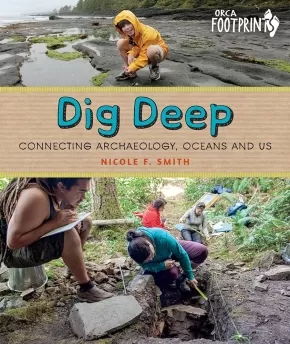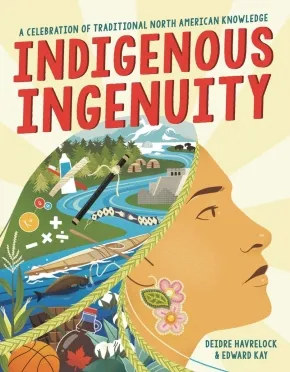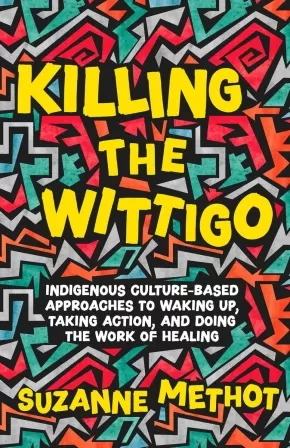
Indigenous Peoples
91
-
105
of
409 Results;
Sort By
Go To
of 28
Wings of an Eagle: The Gold Medal Dreams of Billy Mills
$25.99
Artists:
Format:
Hardcover
Text Content Territories:
Indigenous American; Native American; Sioux; Lakota; Oglala Lakota; Pine Ridge Indian Reservation;
ISBN / Barcode: 9780316373487
Synopsis:
Synopsis:
Just in time for the 2024 Summer Olympics, here is a dramatic and inspiring autobiographical tale of overcoming odds by Native American gold medalist Billy Mills, with stunning illustrations by acclaimed Lakota artist SD Nelson.
Billy Mills was once an orphan on the Oglala Lakota Pine Ridge Reservation. But before his father was called to the ancestors, he told Billy how to conquer his suffering: You have broken wings, son. You have to dig deeper, below the anger, the hurt, the self-pity. The pursuit of a dream will heal you.
Despite poverty, racism, and severe health challenges, Billy raced toward his goal of becoming an Olympic athlete, inspired by his indigenous ancestors who stood strong when the odds were against them. Though at times he felt like his wings were clipped—a lone bird falling from the sky—he adapted and overcame, finally earning his place at the 1964 Olympics.
Educator Information
Recommended for ages 4 to 8.
This autobiographical tale of Billy Mills’s awe-inspiring flight to a record-breaking gold medal, breathtakingly illustrated by award-winning Lakota artist SD Nelson, is a soaring testament to Billy’s legacy and the Lakota prayer: we are all related.
Additional Information
48 pages | 10.00" x 10.00"| Hardcover
Wisdom Weavers: Explore the Ojibwe Language and the Meaning of Dream Catchers
$25.99
Artists:
Format:
Hardcover
Text Content Territories:
Indigenous American; Native American; Anishinaabeg; Ojibwe (Chippewa);
ISBN / Barcode: 9780760387191
Synopsis:
Synopsis:
Follow a day in the life of a young, mixed heritage Ojibwe child and learn key words and phrases from the Ojibwe language in this enchantingly illustrated children’s book.
The Ojibwe people are the largest Indigenous group of Turtle Island, now known as North America, and live around the present-day Great Lakes. After their land was taken by Europeans, many Ojibwe children were placed in boarding schools that forbid them to use their native language. Though this led to a decline in fluent speakers, there is a growing movement to restore the strength of the Ojibwe language.
In Ojibwe culture, a dream catcher (izhi’on) protects people, especially children, from harm by catching bad dreams in its web and allowing good dreams to pass through the feathers hanging at the bottom.
Wisdom Weavers introduces children to the Ojibwe language from an Indigenous perspective. International speaker, author, and creator of Ojibwe Word of the Day, James Vukelich Kaagegaabaw, presents a selection of words and phrases throughout the day while his son learns about the Ojibwe tradition of the dream catcher. Created with children ages 6 to 11 (beginner- to mid-level readers) in mind, Wisdom Weavers is an engaging and accessible way for children to discover the Ojibwe language and learn key phrases and words like:
How to welcome the morning - Mino-giizhigad
How to say I love you - Gizhawenimin
How to be grateful - Miigwech
How to make an offering - Biindaakoojige
School - Gikinoo’amaadiiwigamig
Tree - Mitig
Backpack -Bimiwanaan
Sun - Giizis
And more!
This inspiring story features a total of 73 words and phrases to learn in Ojibwe, introduced throughout the visually captivating and representative scenes showing an average day in an Ojibwe family from illustrator Marcus Trujillo, a tribal member with the Pueblo of Laguna in affiliation with the Village of Paraje. Also featuring a brief history of the Ojibwe people and language and a culturally accurate how-to guide for making a dream catcher at home, Wisdom Weavers immerses young people in a vibrant traditional culture while helping to keep the Ojibwe language and customs alive.
Educator Information
Recommended for ages 6 to 11.
This book includes some words and phrases in Ojibwe, but it is not a fully dual-language book.
Additional Information
32 pages | 8.50" x 11.00" | Hardcover
A Kid's Guide to Plants of the Pacific Northwest: with Cool Facts, Activities and Recipes
$26.95
Format:
Paperback
Text Content Territories:
Indigenous American; Alaska Native; Native American; Indigenous Canadian; First Nations;
ISBN / Barcode: 9781990776212
Synopsis:
Synopsis:
A middle-grade-friendly introduction to Pacific Northwest flora, with outdoor activities, games and quizzes that make learning about nature fun! Great for families and educators.
Get dirty digging up roots. Crouch down to look closely at a carnivorous sundew dissolving a dragonfly. Munch some lemony-tasting miner’s lettuce. Go on a scavenger hunt for some of nature’s more surprising creations, like the arbutus tree, a sculpture of living copper. Make a soothing plantain salve to treat an itch. Learn which berries you can eat and which to avoid.
Time spent outdoors encourages children’s self-confidence and independence, increases attention span and physical well-being, and fosters care for the environment. With the increasing intrusion of technology into daily life, and the challenges of climate chaos, it has never been more essential for parents and educators to encourage kids to engage with the natural environment. Plants are everywhere, even in urban areas where parks, empty lots and backyards offer the opportunity to learn from and connect to nature.
Drawing on her years of experience as a herbalist and outdoor educator, author Philippa Joly features more than fifty richly illustrated plant profiles, including information on identification and ecology, uses in Coastal Indigenous cultures, and fun activities—all in a way that is accessible and interesting to readers of all ages.
Reviews
“This is an absolutely delightful book, dedicated to helping children and youth build relationships with the plants in their world. It is a rich compendium of plant portraits and descriptions, personal stories, recipes, games and hands-on activities—like making tea from Yerba Buena or making a root-digging stick of Oceanspray. Philippa’s obvious love of kids, plants and the natural world shines through—and it is catching!” — Nancy Turner, Professor Emeritus, University of Victoria, and author of Plants of Haida Gwaii
Educator Information
Recommended for ages 6 to 12.
Table of Contents
1. Indigenous Peoples of the Pacific Northwest Coast
2. Regions and Plants Covered by This Book
3. Plant Names and Language
4. Dos and Dont's of Wildcrafting Plants
5. Understanding Plant Families
6. Plant Guilds
7. Poisonous Plants
8. Invasive Plants
9. Plant Profiles
10. For Parents and Educators
Additional Information
232 pages | 8.50" x 8.50" | Paperback
A Little Plains Cree Colouring Book: Plains Cree People
$24.95
Format:
Paperback
Text Content Territories:
Indigenous Canadian; First Nations; Cree (Nehiyawak); Plains Cree;
ISBN / Barcode: 9781778690136
Synopsis:
Synopsis:
A colouring book that teaches the Plains Cree language! A Little Plains Cree Colouring Book—Plains Cree People explores kinship relationships, the names of various family members and careers in the Plains Cree language.
The content focuses on terms familiar to the First Nations Cree people of Saskatchewan and is a companion to nēhiyawēwin awāsi-masinahikanis—A Little Plains Cree Book for Children: A Reference for Teaching the Plains Cree Language. Our hope is to encourage a basic understanding of the language so that learners are able to converse with Plains Cree speakers. The best path to fluency in the Plains Cree language is immersion, but learning one word at a time is a good place to start!
Educator Information
Recommended for ages 3 to 12.
Find companion resources here:
- A Little Plains Cree Book for Children: A Reference for Teaching the Plains Cree Language
- nēhiyawēwin awāsi-masinahikanis: A Little Plains Cree Book for Children—Teaching Guide
Additional Information
56 pages | 8.50" x 11.00" | Paperback
Amazing L’nu’k: A Celebration of the People of Mi'kma'ki
$24.95
Artists:
Format:
Paperback
Text Content Territories:
Indigenous Canadian; First Nations; Mi'kmaq;
ISBN / Barcode: 9781774711682
Synopsis:
Synopsis:
Delve into the uplifting stories of the people of Mi'kma'ki in this full-colour illustrated book. Meet a devoted water protector, learn about a teen determined to shed light on the tragic history of Residential Schools, and discover poets who use words to explore and champion the rich Mi'kmaw culture. From Grand Chief Gabriele Sylliboy and Elder Dorene Bernard to Rebecca Thomas and Landyn Toney, all of these amazing people call Mi'kma'ki (a territory that includes New Brunswick, Prince Edward Island, Nova Scotia, and parts of Newfoundland, Quebec, and Maine) home.
With dozens of profiles featuring artists, athletes, entrepreneurs, scientists, and more — both historical and present-day, from kids to Elders — Julie Pellissier-Lush and Robin Grant celebrate the many brilliant achievements of the Mi'kmaq.
Includes original colour illustrations by James Bentley, informative sidebars, a map of Mi'kmaw territories, a history of Mi'kma'ki , an index, and a glossary.
Educator Information
Recommended for ages 8 to 12
Additional Information
184 pages | 7.00" x 9.00" | Paperback
Animals Illustrated: Arctic Fox
$17.95
Artists:
Format:
Hardcover
Text Content Territories:
Indigenous Canadian; Inuit;
ISBN / Barcode: 9781772274851
Synopsis:
Synopsis:
Animals Illustrated mixes fun-filled animal facts suitable for the youngest of readers with intricately detailed illustrations to create a unique and beautiful collection of children’s non-fiction books about Arctic animals.
Each volume contains first-hand accounts from authors who live in the Arctic, along with interesting facts on the behaviours and biology of each animal. In this book, kids will learn about the many body adaptations that make Arctic foxes perfectly designed for life in the Arctic, as well as some of their amazing abilities—like being able to travel huge distances in search of food, even swimming between islands on their quest!
Educator & Series Information
Recommended Ages: 6-8
This book is part of the non-fiction Animals Illustrated series, which mixes fun-filled animal facts suitable for the youngest of readers with intricately detailed illustrations to create a unique and beautiful collection of children’s non-fiction books on Arctic animals. Each volume contains firsthand accounts from authors who live in the Arctic, along with interesting facts on the behaviours and biology of each animal.
This book is available in French: Renard Arctique.
Additional Information
28 pages | 6.50" x 9.00" | Hardcover
Arctic Song: Creation Stories From the Arctic
$28.95
Artists:
Format:
Hardcover
Text Content Territories:
Indigenous Canadian; Inuit;
Reading Level: N/A
ISBN / Barcode: 9781772274974
Synopsis:
Synopsis:
This poetic journey through Inuit oral history gives a glimpse of traditional beliefs surrounding the creation of the world. From the creation of day and night and the Sun and the Moon, to the origin of Death, this collection of simple retellings is richly supported by the artwork of acclaimed artist Germaine Arnattaujuq.
Featuring a foreword by the artist about her work illustrating Inuit myths and legends, this introduction to traditional Inuit stories is based on the animated film Arctic Song, which was co-produced and co-directed by Germaine Arnattaujuq and Neil Christopher.
Educator Information
Dual-language: English and Inuktitut
Additional Information
72 pages | 9.00" x 10.00" | Hardcover
Autumn Peltier, Water Warrior
$24.99
Format:
Hardcover
Text Content Territories:
Indigenous Canadian; First Nations; Anishinaabeg; Wiikwemkoong Unceded Territory;
ISBN / Barcode: 9781250795274
Synopsis:
Synopsis:
From New York Times bestselling picture book author Carole Lindstrom and illustrator Bridget George comes Autumn Peltier, Water Warrior, an inspiring picture book biography about two Indigenous Rights Activists, Josephine Mandamin and Autumn Peltier.
The seventh generation is creating
A sea of change.
It was a soft voice, at first.
Like a ripple.
But with practice it grew louder.
Indigenous women have always worked tirelessly to protect our water—keeping it pure and clean for the generations to come. Yet there was a time when their voices and teachings were nearly drowned out, leaving entire communities and environments in danger and without clean water.
But then came Grandma Josephine and her great-niece, Autumn Peltier.
Featuring a foreword from water advocate and Indigenous Rights Activist Autumn Peltier herself, this stunning picture book from New York Times-bestselling author Carole Lindstrom and illustrator Bridget George gives voice to the water and asks young readers to join the tidal wave of change.
Educator Information
Recommended for ages 4 to 8.
Additional Information
40 pages | 10.45" x 10.30" | Hardcover
Colonization and the Wampanoag Story
$11.99
Format:
Paperback
Text Content Territories:
Indigenous American; Native American; Wampanoag (Wôpanâak);
ISBN / Barcode: 9780593480434
Synopsis:
Synopsis:
Until now, you've only heard one side of the story: the "discovery" of America told by Christopher Columbus, the Pilgrims, and the Colonists. Here's the true story of America from the Indigenous perspective.
When you think about the beginning of the American story, what comes to mind? Three ships in 1492, or perhaps buckled hats and shoes stepping off of the Mayflower, ready to start a new country. But the truth is, Christopher Columbus, the Pilgrims, and the Colonists didn't arrive to a vast, empty land ready to be developed. They arrived to find people and communities living in harmony with the land they had inhabited for thousands of years, and they quickly disrupted everything they saw.
From its "discovery" by Europeans to the first Thanksgiving, the story of America's earliest days has been carefully misrepresented. Told from the perspective of the New England Indigenous Nations that these outsiders found when they arrived, this is the true story of how America as we know it today began.
Reviews
"A poignant and powerful look at identity, change, and resiliency." —Kirkus Reviews
Educator Information
Recommended for ages 10+.
Additional Information
272 pages | 5.50" x 8.31" | Paperback
Contenders: Two Native Baseball Players, One World Series
$26.99
Artists:
Format:
Hardcover
Text Content Territories:
Indigenous American; Native American; Anishinaabeg; Ojibwe (Chippewa); Minnesota Chippewa Tribe; White Earth Band of Ojibwe; Cahuilla;
ISBN / Barcode: 9780593406472
Synopsis:
Synopsis:
The true story of John Meyers and Charles Bender, who in 1911 became the first two Native pro baseball players to face off in a World Series, teaches important lessons about resilience, doing what you love in the face of injustice, and the fight for Native American representation in sports.
Charles Bender grew up on the White Earth Reservation in Northwestern Minnesota. John Meyers was raised on the Cahuilla reservation in Southern California. Despite their mutual respect for each other's talents and their shared dedication to Native representation in baseball, the media was determined to pit them against each other.
However, they never gave up on their dreams of being pro baseball players and didn’t let the supposed rivalry created by the media or the racism they faced within the stadium stop them. They continued to break barriers and went on to play a combined total of nine championships.
With text by Traci Sorell and illustrations by Arigon Starr that brings these two players to life, the stories of John Meyers and Charles Bender remain an inspiration for achieving and maintaining one’s dreams in the face of prejudice.
Educator Information
Recommended for ages 6 to 9.
Additional Information
48 pages | 11.30" x 9.30" | Hardcover
Dig Deep: Connecting Archaeology, Oceans and Us
$21.95
Format:
Hardcover
Text Content Territories:
Indigenous; Indigenous Canadian; First Nations; Indigenous American; Native American;
ISBN / Barcode: 9781459826083
Synopsis:
Synopsis:
What can archaeology and Indigenous Traditional Knowledge tell us about how our marine environments have changed over time and the effects of climate change?
From harvesting herring eggs to hunting humpback whales, humans have had a relationship with the world's oceans for more than 100,000 years. In Dig Deep: Connecting Archaeology, Oceans and Us, young readers unearth what our ancestors left behind at archaeological sites around the world and examine how tools, campsites, fishing technologies and even garbage can show us how our ancestors lived and how they used the ocean. These discoveries can unearth clues to help keep our oceans healthier today and in the future.
Reviews
“Provides readers with an introduction to archeology…Slim yet informative…Recommended.” — School Library Connection
Educator & Series Information
Recommended for ages 9 to 12.
This book is part of the Orca Footprint series.
Additional Information
48 pages | 8.00" x 9.50" | Hardcover
Every Child Matters
$24.99
Format:
Hardcover
Text Content Territories:
Indigenous Canadian; First Nations; Inuit; Métis;
ISBN / Barcode: 9781778540165
Synopsis:
Synopsis:
Learn the meaning behind the phrase, ‘Every Child Matters.'
Orange Shirt Day founder, Phyllis Webstad, offers insights into this heartfelt movement.
Every Child Matters honours the history and resiliency of Indigenous Peoples on Turtle Island and moves us all forward on a path toward Truth and Reconciliation.
If you're a Residential School Survivor or an Intergenerational Survivor - you matter. For the children who didn't make it home - you matter. The child inside every one of us matters. Every Child Matters.
Reviews
"Every Child Matters speaks to all Indigenous Peoples - past and present - whose lives have been impacted by the residential school system. Phyllis and Karlene beautifully honour the unity, strength and resolve shared by Survivors, their families and their communities. Residential schools took our children and tried to break their vibrant spirits. With this book, the children of today can learn the truths of this history and how they can play a part in making sure every child matters." – Stephanie Scott, Executive Director of the National Center for Truth and Reconciliation
“…a brilliantly illustrated and meticulously written narrative. It is a must read.” - Chief Dr. Robert Joseph, Gwawaenuk, Elder, Reconciliation Canada
Educator Information
Recommended for ages 6 to 10.
Find the accompanying Teacher Lesson Plan resource HERE!
This book is available in French: Chaque enfant compte
Additional Information
44 pages | 8.50" x 11.00" | Hardcover
Haywaas' Question: What Is Reconciliation?
$16.95
Format:
Paperback
Text Content Territories:
Indigenous Canadian; First Nations; Haida;
ISBN / Barcode: 9781738736706
Synopsis:
Synopsis:
After Haywaas sees his parents get frustrated while watching the news, this precocious 12-year-old begins a months-long journey navigating many different answers to what he thought was a simple question.
Expertly crafted by a teacher-parent-author duo, Haywaas’ Question is relatable, understandable, and aptly builds up to an answer we’re all a part of.
Educator Information
The publisher recommends this picture book for Grades 4 - 10.
This book is available in French: La Question de Haywaas: Qu'est-ce que la réconciliation?
Additional Information
36 pages | 7.00" x 9.00" | Paperback
Indigenous Ingenuity: A Celebration of Traditional North American Knowledge (PB)
$12.99
Artists:
Format:
Paperback
ISBN / Barcode: 9780316413435
Synopsis:
Synopsis:
Celebrate Indigenous thinkers and inventions with this beautifully designed, award-winning interactive nonfiction book—perfect for fans of Braiding Sweetgrass.
Corn. Chocolate. Fishing hooks. Boats that float. Insulated double-walled construction. Recorded history and folklore. Life-saving disinfectant. Forest fire management. Our lives would be unrecognizable without these, and countless other, scientific discoveries and technological inventions from Indigenous North Americans.
Spanning topics from transportation to civil engineering, hunting technologies, astronomy, brain surgery, architecture, and agriculture, Indigenous Ingenuity is a wide-ranging STEM offering that answers the call for Indigenous nonfiction by reappropriating hidden history. The book includes fun, simple activities and experiments that kids can do to better understand and enjoy the principles used by Indigenous inventors. Readers of all ages are invited to celebrate traditional North American Indigenous innovation, and to embrace the mindset of reciprocity, environmental responsibility, and the interconnectedness of all life.
Reviews
"An astonishing, exuberant treasure trove of history, science and hands-on activities that repeatedly begs the question: "Why didn't I know this?" Essential for kids and adults. We need this book." —Candace Fleming, award-winning author of The Rise and Fall of Charles Lindbergh and The Family Romanov
"This book will amaze readers and teachers as it demonstrates how pervasive and critical the history of Indigenous people is. A completely unique and important narrative not to be missed; readers and teachers will come away with a new appreciation for the myriad contributions Indigenous people have made."—SLJ, starred review
"A conversational tone invites readers to engage with this monumental collection . . . Curious readers will learn facts unique to individual tribal groups while gaining knowledge of STEM/STEAM concepts. An ambitious, appealing, and accessible work documenting and protecting valuable knowledge."—Kirkus Reviews
"Engaging and informative, this will be welcomed by both STEM and social studies curricula to help to correct prevailing narratives about Indigenous technology."—Booklist, starred review
"Via authoritative, meticulously researched prose, the creators detail Native peoples’ significant strides in scientific pursuits . . . [and] showcase Native tribes’ continual and enduring impact. Photographs, as well as interactive activities detailing recipes and science experiments, feature throughout, lending a hands-on approach to this clear and concise work."—Publishers Weekly
"This book is a valuable contribution to efforts to decolonize learning and introduce readers to the breadth of indigenous knowledge as practiced in widely disparate geographic zones."—Canadian Review of Materials
"An engaging and cleverly compiled guide to North American and Mesoamerican Indigenous innovation. STEM topics (housing, medicine, clothing, agriculture, and hunting among them) are compellingly and conversationally discussed."—Shelf Awareness
Educator Information
Recommended for ages 8 to 12.
Fountas & Pinnell Text Level Gradient: Z
Additional Information
288 pages | 6.95" x 9.00" | Paperback
Killing the Wittigo: Indigenous Culture-Based Approaches to Waking Up, Taking Action, and Doing the Work of Healing
$29.95
Format:
Paperback
ISBN / Barcode: 9781770417243
Synopsis:
Synopsis:
An unflinching reimagining of Legacy: Trauma, Story, and Indigenous Healing for young adults.
Written specifically for young adults, reluctant readers, and literacy learners, Killing the Wittigo explains the traumatic effects of colonization on Indigenous people and communities and how trauma alters an individual’s brain, body, and behavior. It explores how learned patterns of behavior — the ways people adapt to trauma to survive — are passed down within family systems, thereby affecting the functioning of entire communities. The book foregrounds Indigenous resilience through song lyrics and as-told-to stories by young people who have started their own journeys of decolonization, healing, and change. It also details the transformative work being done in urban and on-reserve communities through community-led projects and Indigenous-run institutions and community agencies. These stories offer concrete examples of the ways in which Indigenous peoples and communities are capable of healing in small and big ways — and they challenge readers to consider what the dominant society must do to create systemic change. Full of bold graphics and illustration, Killing the Wittigo is a much-needed resource for Indigenous kids and the people who love them and work with them.
Educator Information
Recommended for ages 12 to 17.
The adult version of this book can be found here: Legacy: Trauma, Story, and Indigenous Healing
Additional Information
160 pages | 5.50" x 8.50" | Paperback
Sort By
Go To
of 28

